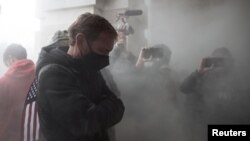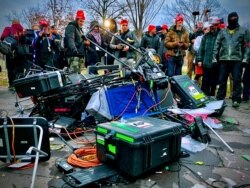Face to face with a maskless man threatening to shoot her, Amanda Andrade-Rhoades had limited options.
The freelance photojournalist was working solo on assignment for The Washington Post Wednesday of last week as supporters of President Donald Trump descended on the U.S. Capitol, rioting as Congress voted to certify the 2020 election results.
The man was tall and older, with a mustache and a tan jacket, Andrade-Rhoades told VOA. Coming within inches of her face, he said, "I'm coming back with a gun for tomorrow, and I'm coming back for you."
She had limited protection — no bulletproof vest, no people around to help — and saw no reason to escalate the conflict. She walked away.
By the end of the day, Andrade-Rhoades says, she had been struck by four rubber bullets — three in the leg and one in the upper hip — as police clashed with rioters, and three people had threatened to shoot her.
The journalist is one of several who say they were attacked or threatened by the rioters last Wednesday. Footage showed crowds smashing equipment belonging to an Associated Press crew, charging and yelling at reporters, and dragging a photographer backward over a ledge. On a door inside the U.S. Capitol someone scrawled "Murder the Media."
The U.S. Press Freedom Tracker, a coalition of free-speech advocates, news organizations and journalism advocacy groups, is investigating about 15 attacks and five arrests or detainments of journalists across the U.S.
Michael Sherwin, acting U.S. attorney for the District of Columbia, said Tuesday his office will investigate and prosecute violence toward journalists.
"Some people aren't familiar that some of those rioters specifically targeted members of the media and assaulted them," Sherwin said at a news conference, adding that he has set up a strike force to focus on media assaults.
The attacks come after an unprecedented year of hostility toward the press in the U.S., most taking place while media covered rallies calling for racial equality following the death of George Floyd, a Black man killed in police custody in Minneapolis, and clashes with police and protesters.
The Tracker documented more than 325 attacks against journalists in 2020 and 123 arrests — by far the most it had ever recorded in a year. It is also working to verify about 200 additional incidents that took place last year, managing editor Kirstin McCudden told VOA.
Now, journalists and newsrooms are confronting an unsettling reality: The U.S. is becoming an increasingly dangerous place to be a journalist. And they are beginning to take extra precautions to ensure reporters are safe.
"We shouldn't have to be doing our work in fear," Andrade-Rhoades said. "But this is the way it is now."
Widespread hostility
The hostility wasn't confined to the capital. Last Wednesday, Rick Egan was photographing a rally of Trump supporters at Utah's state capitol for The Salt Lake Tribune.
At one point, a man yelled into a bullhorn next to his face, "Look at you and your mask you [expletives]."
Within minutes, the same man returned, this time spraying pepper spray in his eyes.
"I didn't do anything to him. It was just totally out of nowhere," Egan said. "Just the freakiest, craziest thing I've encountered in my work as a journalist."
In first-person accounts shared widely on social media and at U.S. outlets, some reporters likened events to their days as war correspondents.
Journalists say they have become used to increased hostility in recent years, with people hurling insults or pushing them. But those incidents are "nothing close to what happened" last week, Egan said.
Andrade-Rhoades said she thinks the hostility is due in part to "inflammatory rhetoric" including from the president, who has had a tense relationship with large sections of the press, whom he has regularly labeled as "fake news" and "enemy of the people."
Trump and many of his supporters believe the mainstream media has been biased in its reporting of him and are attempting to delegitimize his presidency with overly critical coverage. A growth in disinformation on social media has further weakened trust in the media.
Egan has noticed a similar change in rhetoric over the past four years. More recently, he said, people hurl insults at him over wearing a mask.
"It can be a bunch of [people] ... upset about having to wear masks, and they still attack us and verbally yell and scream," he said. "It's just crazy. It never happened before. I was never worried for my safety."
The wearing of masks has become a flashpoint for anger across the world, with people on one side seeing it as a necessary measure to try to prevent the spread of the coronavirus, and others viewing it as an attempt to limit their freedoms.
A push for safety
As protests calling for racial equality became more intense, Andrade-Rhoades invested in protective gear.
The Salt Lake Tribune, where Egan works, ordered safety kits last Wednesday for staff. The kits include protective gear, such as gloves, and there are plans to order helmets for staffers.
Journalists are also participating in more official training.
"They want us on the front lines. They want us to tell these stories," Egan said. "But they want us to be safe."
Frank Smyth is the executive director of GJS Security, a U.S. company that provides hostile environment and emergency first aid training. The company saw trainings skyrocket in 2020 as journalists confronted more dangerous situations, he said.
The company's curriculum includes civil unrest, police tactics with the press and an hourlong course on "stopping the bleed" — essentially emergency first aid.
The company began offering civil unrest training to journalists covering the U.S. in 2016. They provided a few dozen training sessions and by 2020 had conducted more than double the training than four years earlier, Smyth said.
But Smyth, who authored a UNESCO report on increasing dangers to the media covering protests globally and whose company usually focuses on training for reporters working in places such as Iraq, Afghanistan and Venezuela, isn't proud of the increased business.
"The fact that this is happening at home is alarming," he told VOA. "It saddens me that we're in this situation. It saddens me that people need training to operate in the United States."
The International Women's Media Foundation (IWMF) also provides training — offering courses to 1,096 journalists last year, said program coordinator Maria Alejandra Silva Ortega. That's an exponential rise from the 122 they trained in 2019 — something she attributed to both the accessibility of classes during COVID-19 and the increased demand.
"Newsrooms are realizing that they also have a responsibility to ensure the safety of their journalists," she told VOA.
For Smyth, the increased demand is concerning, and he's worried about the future safety of journalists in the U.S.
"The United States is now a hostile environment for the press. I don't think that is hyperbolic to say," he said.






